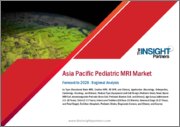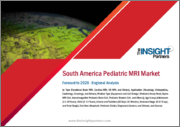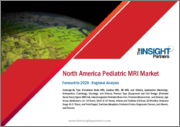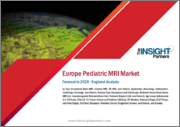
|
시장보고서
상품코드
1394058
아시아태평양의 소아용 MRI 시장 예측(-2028년) : 지역별 분석 - 유형, 응용 분야, 제품 유형, 연령대, 최종 사용자별Asia Pacific Pediatric MRI Market Forecast to 2028 - Regional Analysis - by Type, Application, Product Type, Age Group, and End User |
||||||
아시아태평양의 소아용 MRI 시장은 2022년 6억 7,085만 달러로 평가되었고, 2028년에는 10억7,781만 달러에 달할 것으로 예상되며, 2022년부터 2028년까지 CAGR 8.2%로 성장할 것으로 전망됩니다.
소아용 MRI 시뮬레이터 사용으로 소아용 MRI 시장 활성화
자기공명영상장치(MRI)를 받는 경험은 특히 소아 환자와 그 가족에게 불안감을 줄 수 있습니다. 그래서 소아는 종종 진정제를 투여하고 검사를 받습니다. 그러나 진정제 사용은 검사 비용을 증가시키고, 검사 중 마취과 의사의 입회하에 검사를 진행해야 합니다. 마취가 필요한 시술 횟수를 줄이는 새로운 기술과 시뮬레이션을 도입하여 성공률을 높이고 진정제를 사용하지 않는 경험을 보장하는 대체 방법을 구현할 수 있으며, MRI 시뮬레이터를 사용하여 어린이를 스캔하고 진정이 필요한지 여부를 평가할 수 있습니다. 평가할 수 있습니다. 가상현실은 헤드마운트디스플레이(HMD)를 통해 체험할 수 있는 3D 환경의 컴퓨터 생성 시뮬레이션으로, 시술에 대한 두려움 등 다양한 소아 심리학적 응용 분야에서 불안을 완화하는 효과적인 솔루션으로 부상하고 있습니다. 예를 들어, Philips 헬스케어의 앰비언트 익스피리언스(Ambient Experience) 프로그램은 건축, 디자인, 조명, 음향 등 다양한 기술을 활용해 편안한 검사 환경을 조성하고 있습니다. 보어 커넥트(Bient Experience in Bore Connect)를 통해 보어 내에 영상을 투사하여 환자를 진정시키고 안내합니다. 2021년 3월, Philips와 월트디즈니 컴퍼니는 Philips 앰비언트 익스피리언스에서 디즈니 스토리와 같은 맞춤형 애니메이션의 효과를 테스트했습니다. 맞춤형 애니메이션의 효과를 테스트했습니다. 디즈니 애니메이션 스토리에는 미키마우스, 아리엘, 마블의 어벤져스, 스타워즈의 요다 등 다양한 디즈니 캐릭터가 등장합니다. 따라서 어린이들이 MRI 검사에 적응할 수 있도록 이러한 기술과 놀이를 기반으로 한 시뮬레이터의 도입은 예측 기간 동안 시장 성장을 가속할 것으로 보입니다.
아태지역 소아용 MRI 시장 개요
아시아태평양의 소아용 MRI 시장은 중국, 일본, 인도, 호주, 한국, 기타 아시아태평양으로 구분됩니다. 이 시장은 R&D 활동 증가, 혁신적인 기술 및 제품 채택, 소아 질환의 유병률 증가로 인한 MRI 장비의 사용 증가 등의 요인에 의해 주도되고 있습니다. 최근 일본에서는 교통사고가 급증하면서 소아용 MRI에 대한 수요가 증가하고 있습니다. 소아용 MRI는 부상, 질병, 선천성 기형 등으로 인한 소아의 다양한 증상을 진단하는 데 사용됩니다. 낭종, 종양, 출혈, 부종, 혈관 문제 등 다양한 뇌의 상태와 이상을 감지합니다. 이러한 요인들이 일본 소아용 MRI 시장의 성장을 견인하고 있습니다.
아시아태평양의 소아용 MRI 시장 수익 및 2028년까지의 예측(금액)
아태지역 소아용 MRI 시장 세분화
아시아태평양의 소아용 MRI 시장은 유형, 용도, 제품 유형, 연령대, 최종 사용자, 국가별로 분류됩니다. 유형별로 아시아태평양의 소아용 MRI 시장은 뇌기능 MRI, 심장 MRI, 4D MRI, 기타로 구분되며, 2022년 뇌기능 MRI 분야가 가장 큰 시장 점유율을 차지할 것으로 예상됩니다.
용도별로는 아시아태평양의 소아용 MRI 시장은 신경학, 정형외과, 심장학, 종양학, 기타로 구분되며, 2022년에는 신경학 분야가 가장 큰 시장 점유율을 차지할 것으로 예상됩니다.
제품 유형별로는 아시아태평양의 소아용 MRI 시장은 장비와 코일 설계로 나뉘며, 2022년 시장 점유율은 장비 부문이 더 클 것으로 예상됩니다.
연령대별로는 아태지역 소아용 MRI 시장은 사춘기(11-18세), 소아(2-11세), 영아(생후 28일-23개월), 신생아(0-27일), 태아로 나뉩니다. 청소년기(11-18세) 부문이 2022년 가장 큰 시장 점유율을 차지했습니다.
최종 사용자별로 아시아태평양의 소아용 MRI 시장은 병원, 소아과 진료소, 진단센터, 기타로 구분됩니다. 병원 부문이 2022년 가장 큰 시장 점유율을 차지했습니다.
국가별로 보면 아시아태평양의 소아용 MRI 시장은 중국, 일본, 인도, 호주, 한국, 기타 아시아태평양으로 나뉘며, 2022년 아시아태평양의 소아용 MRI 시장 점유율은 일본이 독주했습니다.
GE HealthCare Technologies Inc, Hyperfine Inc, Koninklijke Philips NV, LMT Medical Systems GmbH, Siemens Healthineers AG, Time Medical Holding, 아시아태평양의 소아용 MRI 시장에서 사업을 전개하는 주요 기업 중 일부입니다.
목차
제1장 서론
제2장 주요 요약
제3장 조사 방법
- 조사 범위
- 2차 조사
- 1차 조사
제4장 아시아태평양의 소아용 MRI 시장 - 시장 구도
- 개요
- PEST 분석
- 아시아태평양의 PEST 분석
- 전문가의 견해
제5장 아시아태평양의 소아용 MRI 시장 - 주요 시장 역학
- 시장 성장 촉진요인
- 시장 성장 억제요인
- 시장 기회
- 향후 동향
- 영향 분석
제6장 소아용 MRI 시장 : 아시아태평양 분석
- 아시아태평양의 소아용 MRI 시장 매출 예측과 분석
제7장 아시아태평양의 소아용 MRI 시장 - 유형별 매출과 2028년까지 예측
- 소아용 MRI 시장 유형별 매출 점유율(2022년, 2028년)
- 뇌기능 MRI(fMRI)
- 심장 MRI
- 4D MRI
- 기타
제8장 아시아태평양의 소아용 MRI 시장 - 매출과 2028년까지 예측 : 용도별
- 소아용 MRI 시장 용도별 매출 점유율(2022년 및 2028년)
- 신경학
- 정형외과
- 순환기
- 종양학
- 기타
제9장 아시아태평양의 소아용 MRI 시장 : 매출과 2028년까지 예측 : 제품 유형별
- 소아용 MRI 시장 제품 유형별 매출 점유율(2022년, 2028년)
- 장비
- 코일 설계
제10장 아시아태평양의 소아용 MRI 시장 : 매출과 2028년까지 예측 : 연령층별
- 소아용 MRI 시장 연령층별 점유율(2022년 및 2028년)
- 태아기
- 신생아기(0-27일)
- 유아기(28일-23개월)
- 소아기(2-11세)
- 청년기(12-18세)
제11장 아시아태평양의 소아용 MRI 시장 : 매출과 2028년까지 예측 : 최종사용자별
- 소아용 MRI 시장 최종사용자별 점유율(2022년, 2028년)
- 병원
- 소아과 클리닉
- 진단센터
- 기타
제12장 아시아태평양의 소아용 MRI 시장 : 매출과 2028년까지 예측 : 국가별 분석
제13장 아시아태평양의 소아용 MRI 시장 - 업계 상황
- 소아용 MRI 시장 성장 전략
- 유기적 성장 전략
- 무기적 성장 전략
- 성장 전략
제14장 기업 개요
- Siemens Healthineers AG
- LMT Medical Systems GmbH
- Hyperfine Inc
- GE HealthCare Technologies Inc
- Koninklijke Philips NV
- Time Medical Holding
제15장 부록
LSH 23.12.21The Asia Pacific pediatric MRI market was valued at US$ 670.85 million in 2022 and is expected to reach US$ 1,077.81 million by 2028; it is estimated to grow at a CAGR of 8.2% from 2022 to 2028.
Use of MRI Simulators to Adapt Children to MRI Scanners Fueling the Pediatric MRI Market
The experience of undergoing magnetic resonance imaging (MRI) can lead to anxiety, particularly for pediatric patients and their families. As a result, children are often sedated to complete the exam. However, sedation increases the cost of the procedure and requires an anesthesiologist to be present during the exam. Alternative methods to improve success and ensure non-sedation experience can be implemented with the adoption of new technologies and simulations that reduce the number of procedures requiring anesthesia. An MRI simulator can be used on children to scan and assess if they need sedation; it is available in various forms. Virtual reality, a computer-generated simulation of a 3D environment that can be experienced using a head-mounted display (HMD), has emerged as an effective solution for reducing anxiety in various pediatric psychological applications, including fear of the procedure. For instance, the Ambient Experience program by Philips Healthcare incorporates architecture, design, and other technologies for lighting and sound to create a relaxed environment for the scan. For MRI scans, Philips offers the Ambient Experience in-bore Connect, which projects videos inside the bore to calm and instruct patients. The children can select a theme, which can be played in the room before the scan and inside the bore during the scan. In March 2021, Philips and The Walt Disney Company collaborated to test the effects of custom-made animation, such as specially made Disney stories, in the Philips Ambient Experience. A few of Disney animation stories featured Mickey Mouse, Ariel, Marvel's Avengers, Star Wars' Yoda, and other Disney characters. Therefore, the implementation of such technologies and play-based simulators to help children adapt to MRI scans is expected to boost the market growth during the forecast period.
Asia Pacific Pediatric MRI Market Overview
The pediatric MRI market in Asia Pacific is segmented into China, Japan, India, Australia, South Korea, and the Rest of Asia Pacific. The market is driven by factors such as increasing number of R&D activities, adoption of innovative technologies and products, and rising use of MRI devices owing to the growing prevalence of pediatric diseases in the region. In recent years, Japan has experienced an enormous increase in road traffic accidents, which drives the demand for pediatric MRI. It is used to help diagnose a wide range of conditions in children that are caused due to injury, illness, or congenital abnormalities. It detects a variety of brain conditions and abnormalities such as cysts, tumors, bleeding, swelling, and problems with the blood vessels. Such aforementioned factors boost the pediatric MRI market growth in Japan.
Asia Pacific Pediatric MRI Market Revenue and Forecast to 2028 (US$ Million)
Asia Pacific Pediatric MRI Market Segmentation
The Asia Pacific pediatric MRI market is segmented based on type, application, product type, age group, end user, and country. Based on type, the Asia Pacific pediatric MRI market is segmented into functional brain MRI, cardiac MRI, 4D MRI, and others. The functional brain MRI segment held the largest market share in 2022.
Based on application, the Asia Pacific pediatric MRI market is segmented into neurology, orthopedics, cardiology, oncology, and others. The neurology segment held the largest market share in 2022.
Based on product type, the Asia Pacific pediatric MRI market is bifurcated into equipment and coil design. The equipment segment held a larger market share in 2022.
Based on age group, the Asia Pacific pediatric MRI market is segmented into adolescent (11-18 Years), child (2-11 Years), infants and toddlers (28 Days-23 Months), neonatal stage (0-27 Days), and fetal stage. The adolescent (11-18 Years) segment held the largest market share in 2022.
Based on end user, the Asia Pacific pediatric MRI market is segmented into hospitals, pediatric clinics, diagnostic centers, and others. The hospitals segment held the largest market share in 2022.
Based on country, the Asia Pacific pediatric MRI market is segmented into China, Japan, India, Australia, South Korea, and the Rest of Asia Pacific. Japan dominated the Asia Pacific pediatric MRI market share in 2022.
GE HealthCare Technologies Inc, Hyperfine Inc, Koninklijke Philips NV, LMT Medical Systems GmbH, Siemens Healthineers AG, and Time Medical Holding are some of the leading players operating in the Asia Pacific pediatric MRI market.
Reasons to Buy:
- Save and reduce time carrying out entry-level research by identifying the growth, size, leading players, and segments in the Asia Pacific pediatric MRI market.
- Highlights key business priorities in order to assist companies to realign their business strategies
- The key findings and recommendations highlight crucial progressive industry trends in the Asia Pacific pediatric MRI market, thereby allowing players across the value chain to develop effective long-term strategies
- Develop/modify business expansion plans by using substantial growth offering developed and emerging markets
- Scrutinize in-depth Asia Pacific market trends and outlook coupled with the factors driving the Asia Pacific pediatric MRI market, as well as those hindering it
- Enhance the decision-making process by understanding the strategies that underpin commercial interest with respect to client products, segmentation, pricing, and distribution
Table Of Contents
1. Introduction
- 1.1 Scope of the Study
- 1.2 The Insight Partners Research Report Guidance
- 1.3 Market Segmentation
- 1.3.1 Asia Pacific Pediatric MRI Market - By Type
- 1.3.2 Asia Pacific Pediatric MRI Market - By Application
- 1.3.3 Asia Pacific Pediatric MRI Market - By Product Type
- 1.3.4 Asia Pacific Pediatric MRI Market - By Age Group
- 1.3.5 Asia Pacific Pediatric MRI Market - By End User
- 1.3.6 Asia Pacific Pediatric MRI Market- By Country
2. Key Takeaways
3. Research Methodology
- 3.1 Coverage
- 3.2 Secondary Research
- 3.3 Primary Research
4. Asia Pacific Pediatric MRI Market- Market Landscape
- 4.1 Overview
- 4.2 PEST Analysis
- 4.2.1 Asia Pacific - PEST Analysis
- 4.3 Experts Opinion
5. Asia Pacific Pediatric MRI Market - Key Market Dynamics
- 5.1 Market Drivers
- 5.1.1 The Rising Number of Premature Births, and Pediatric Diseases
- 5.1.2 Adoption of Digital Health Technology to Improve Patient Care
- 5.2 Market Restraints
- 5.2.1 Limitations and Safety Challenges Associated with Pediatric MRI
- 5.3 Market Opportunities
- 5.3.1 Increasing Campaigns to Create Awareness Regarding Pediatric Safety
- 5.4 Future Trends
- 5.4.1 Use of MRI Simulators to Adapt Children to MRI Scanners
- 5.5 Impact Analysis
6. Pediatric MRI Market- Asia Pacific Analysis
- 6.1 Asia Pacific Pediatric MRI Market Revenue Forecast and Analysis
7. Asia Pacific Pediatric MRI Market - Revenue and Forecast to 2028 - by Type
- 7.1 Overview
- 7.2 Pediatric MRI Market Revenue Share, by Type (2022 and 2028)
- 7.3 Functional Brain MRI (fMRI)
- 7.3.1 Overview
- 7.3.2 Functional Brain MRI (fMRI): Pediatric MRI Market - Revenue and Forecast to 2028 (US$ Million)
- 7.4 Cardiac MRI
- 7.4.1 Overview
- 7.4.2 Cardiac MRI: Pediatric MRI Market - Revenue and Forecast to 2028 (US$ Million)
- 7.5 4D MRI
- 7.5.1 Overview
- 7.5.2 4D MRI: Pediatric MRI Market - Revenue and Forecast to 2028 (US$ Million)
- 7.6 Others
- 7.6.1 Overview
- 7.6.2 Others: Pediatric MRI Market - Revenue and Forecast to 2028 (US$ Million)
8. Asia Pacific Pediatric MRI Market - Revenue and Forecast to 2028- By Application
- 8.1 Overview
- 8.2 Pediatric MRI Market Revenue Share, by Application (2022 and 2028)
- 8.3 Neurology
- 8.3.1 Overview
- 8.3.2 Neurology: Pediatric MRI Market - Revenue and Forecast to 2028 (US$ Million)
- 8.4 Orthopedics
- 8.4.1 Overview
- 8.4.2 Orthopedics: Pediatric MRI Market - Revenue and Forecast to 2028 (US$ Million)
- 8.5 Cardiology
- 8.5.1 Overview
- 8.5.2 Cardiology: Pediatric MRI Market - Revenue and Forecast to 2028 (US$ Million)
- 8.6 Oncology
- 8.6.1 Overview
- 8.6.2 Oncology: Pediatric MRI Market - Revenue and Forecast to 2028 (US$ Million)
- 8.7 Others
- 8.7.1 Overview
- 8.7.2 Others: Pediatric MRI Market - Revenue and Forecast to 2028 (US$ Million)
9. Asia Pacific Pediatric MRI Market - Revenue and Forecast to 2028- By Product Type
- 9.1 Overview
- 9.2 Pediatric MRI Market Revenue Share, by Product Type (2022 and 2028)
- 9.3 Equipment
- 9.3.1 Overview
- 9.3.2 Equipment: Pediatric MRI Market - Revenue and Forecast to 2028 (US$ Million)
- 9.4 Coil Design
- 9.4.1 Overview
- 9.4.2 Coil Design: Pediatric MRI Market - Revenue and Forecast to 2028 (US$ Million)
- 9.4.3 Pediatric Head/Neck/Spine (HNS) MRI Coil
- 9.4.3.1 Overview
- 9.4.3.2 Pediatric Head/Neck/Spine (HNS) MRI Coil: Pediatric MRI Market - Revenue and Forecast to 2028 (US$ Million)
- 9.4.4 Pediatric Blanket Coil
- 9.4.4.1 Overview
- 9.4.4.2 Pediatric Blanket Coil: Pediatric MRI Market - Revenue and Forecast to 2028 (US$ Million)
- 9.4.5 Interchangeable Pediatric Brain Coil Set
- 9.4.5.1 Overview
- 9.4.5.2 Specifications of the Three Types of Interchangeable Pediatric Brain Coils
- 9.4.5.3 Interchangeable Pediatric Brain Coil Set: Pediatric MRI Market - Revenue and Forecast to 2028 (US$ Million)
- 9.4.6 Others
- 9.4.6.1 Overview
- 9.4.6.2 Others: Pediatric MRI Market - Revenue and Forecast to 2028 (US$ Million)
10. Asia Pacific Pediatric MRI Market - Revenue and Forecast to 2028- By Age Group
- 10.1 Overview
- 10.2 Pediatric MRI Market Share, by Age Group, 2022 and 2028, (%)
- 10.3 Fetal Stage
- 10.3.1 Overview
- 10.3.2 Fetal Stage: Pediatric MRI Market - Revenue and Forecast to 2028 (US$ Million)
- 10.4 Neonatal Stage (0-27 Days)
- 10.4.1 Overview
- 10.4.2 Neonatal Stage: Pediatric MRI Market - Revenue and Forecast to 2028 (US$ Million)
- 10.5 Infant and Toddler (28 Days To 23 Months)
- 10.5.1 Overview
- 10.5.2 Infant and Toddler: Pediatric MRI Market- Revenue and Forecast to 2028 (US$ Million)
- 10.6 Child (2-11 Years)
- 10.6.1 Overview
- 10.6.2 Child: Pediatric MRI Market - Revenue and Forecast to 2028 (US$ Million)
- 10.7 Adolescents (12 To 18 Years)
- 10.7.1 Overview
- 10.7.2 Adolescents: Pediatric MRI Market - Revenue and Forecast to 2028 (US$ Million)
11. Asia Pacific Pediatric MRI Market - Revenue and Forecast to 2028- By End User
- 11.1 Overview
- 11.2 Pediatric MRI Market Share, by End User, 2022 and 2028, (%)
- 11.3 Hospitals
- 11.3.1 Overview
- 11.3.2 Hospitals: Pediatric MRI Market - Revenue and Forecast to 2028 (US$ Million)
- 11.4 Pediatric Clinics
- 11.4.1 Overview
- 11.4.2 Pediatric Clinics: Pediatric MRI Market - Revenue and Forecast to 2028 (US$ Million)
- 11.5 Diagnostic Centres
- 11.5.1 Overview
- 11.5.2 Diagnostic Centres: Pediatric MRI Market - Revenue and Forecast to 2028 (US$ Million)
- 11.6 Others
- 11.6.1 Overview
- 11.6.2 Others: Pediatric MRI Market - Revenue and Forecast to 2028 (US$ Million)
12. Asia Pacific Pediatric MRI Market - Revenue and Forecast to 2028 - by Country Analysis
- 12.1
- 12.2 Asia Pacific: Pediatric MRI Market
- 12.2.1 Overview
- 12.2.2 Asia Pacific: Pediatric MRI Market, by Country, 2022 & 2028 (%)
- 12.2.2.1 China: Pediatric MRI Market - Revenue and Forecast to 2028 (USD Million)
- 12.2.2.1.1 Overview
- 12.2.2.1.2 China: Pediatric MRI Market, Number of Anatomy Scans
- 12.2.2.1.3 China: Pediatric MRI Market - Revenue and Forecast to 2028 (USD Million)
- 12.2.2.1.4 China: Pediatric MRI Market, By Type, 2020-2028 (USD Million)
- 12.2.2.1.5 China: Pediatric MRI Market, by Application, 2020-2028 (USD Million)
- 12.2.2.1.6 China: Pediatric MRI Market, by Product Type, 2020-2028 (USD Million)
- 12.2.2.1.6.1 China: Pediatric MRI Market, by Coil Design, 2020-2028 (USD Million)
- 12.2.2.1.7 China: Pediatric MRI Market, by Age Group, 2020-2028 (USD Million)
- 12.2.2.1.8 China: Pediatric MRI Market, by End User, 2020-2028 (USD Million)
- 12.2.2.2 Japan: Pediatric MRI Market - Revenue and Forecast to 2028 (USD Million)
- 12.2.2.2.1 Overview
- 12.2.2.2.2 Japan: Pediatric MRI Market, Number of Anatomy Scans
- 12.2.2.2.3 Japan: Pediatric MRI Market - Revenue and Forecast to 2028 (USD Million)
- 12.2.2.2.4 Japan: Pediatric MRI Market, By Type, 2020-2028 (USD Million)
- 12.2.2.2.5 Japan: Pediatric MRI Market, by Application, 2020-2028 (USD Million)
- 12.2.2.2.6 Japan: Pediatric MRI Market, by Product Type, 2020-2028 (USD Million)
- 12.2.2.2.6.1 Japan: Pediatric MRI Market, by Coil Design, 2020-2028 (USD Million)
- 12.2.2.2.7 Japan: Pediatric MRI Market, by Age Group, 2020-2028 (USD Million)
- 12.2.2.2.8 Japan: Pediatric MRI Market, by End User, 2020-2028 (USD Million)
- 12.2.2.3 India: Pediatric MRI Market - Revenue and Forecast to 2028 (USD Million)
- 12.2.2.3.1 Overview
- 12.2.2.3.2 India: Pediatric MRI Market, Number of Anatomy Scans
- 12.2.2.3.3 India: Pediatric MRI Market - Revenue and Forecast to 2028 (USD Million)
- 12.2.2.3.4 India: Pediatric MRI Market, By Type, 2020-2028 (USD Million)
- 12.2.2.3.5 India: Pediatric MRI Market, by Application, 2020-2028 (USD Million)
- 12.2.2.3.6 India: Pediatric MRI Market, by Product Type, 2020-2028 (USD Million)
- 12.2.2.3.6.1 India: Pediatric MRI Market, by Coil Design, 2020-2028 (USD Million)
- 12.2.2.3.7 India: Pediatric MRI Market, by Age Group, 2020-2028 (USD Million)
- 12.2.2.3.8 India: Pediatric MRI Market, by End User, 2020-2028 (USD Million)
- 12.2.2.4 Australia: Pediatric MRI Market - Revenue and Forecast to 2028 (USD Million)
- 12.2.2.4.1 Overview
- 12.2.2.4.2 Australia: Pediatric MRI Market, Number of Anatomy Scans
- 12.2.2.4.3 Australia: Pediatric MRI Market - Revenue and Forecast to 2028 (USD Million)
- 12.2.2.4.4 Australia: Pediatric MRI Market, By Type, 2020-2028 (USD Million)
- 12.2.2.4.5 Australia: Pediatric MRI Market, by Application, 2020-2028 (USD Million)
- 12.2.2.4.6 Australia: Pediatric MRI Market, by Product Type, 2020-2028 (USD Million)
- 12.2.2.4.6.1 Australia: Pediatric MRI Market, by Coil Design, 2020-2028 (USD Million)
- 12.2.2.4.7 Australia: Pediatric MRI Market, by Age Group, 2020-2028 (USD Million)
- 12.2.2.4.8 Australia: Pediatric MRI Market, by End User, 2020-2028 (USD Million)
- 12.2.2.5 South Korea: Pediatric MRI Market - Revenue and Forecast to 2028 (USD Million)
- 12.2.2.5.1 Overview
- 12.2.2.5.2 South Korea: Pediatric MRI Market, Number of Anatomy Scans
- 12.2.2.5.3 South Korea: Pediatric MRI Market - Revenue and Forecast to 2028 (USD Million)
- 12.2.2.5.4 South Korea: Pediatric MRI Market, By Type, 2020-2028 (USD Million)
- 12.2.2.5.5 South Korea: Pediatric MRI Market, by Application, 2020-2028 (USD Million)
- 12.2.2.5.6 South Korea: Pediatric MRI Market, by Product Type, 2020-2028 (USD Million)
- 12.2.2.5.6.1 South Korea: Pediatric MRI Market, by Coil Design, 2020-2028 (USD Million)
- 12.2.2.5.7 South Korea: Pediatric MRI Market, by Age Group, 2020-2028 (USD Million)
- 12.2.2.5.8 South Korea: Pediatric MRI Market, by End User, 2020-2028 (USD Million)
- 12.2.2.6 Rest of Asia Pacific: Pediatric MRI Market - Revenue and Forecast to 2028 (USD Million)
- 12.2.2.6.1 Overview
- 12.2.2.6.2 Rest of Asia Pacific: Pediatric MRI Market - Revenue and Forecast to 2028 (USD Million)
- 12.2.2.6.3 Rest of Asia Pacific: Pediatric MRI Market, By Type, 2020-2028 (USD Million)
- 12.2.2.6.4 Rest of Asia Pacific: Pediatric MRI Market, by Application, 2020-2028 (USD Million)
- 12.2.2.6.5 Rest of Asia Pacific: Pediatric MRI Market, by Product Type, 2020-2028 (USD Million)
- 12.2.2.6.5.1 Rest of Asia Pacific: Pediatric MRI Market, by Coil Design, 2020-2028 (USD Million)
- 12.2.2.6.6 Rest of Asia Pacific: Pediatric MRI Market, by Age Group, 2020-2028 (USD Million)
- 12.2.2.6.7 Rest of Asia Pacific: Pediatric MRI Market, by End User, 2020-2028 (USD Million)
- 12.2.2.1 China: Pediatric MRI Market - Revenue and Forecast to 2028 (USD Million)
13. Asia Pacific Pediatric MRI Market-Industry Landscape
- 13.1 Overview
- 13.2 Growth Strategies in Pediatric MRI Market
- 13.3 Organic Growth Strategies
- 13.3.1 Overview
- 13.4 Inorganic Growth Strategies
- 13.4.1 Overview
14. Company Profiles
- 14.1 Siemens Healthineers AG
- 14.1.1 Key Facts
- 14.1.2 Business Description
- 14.1.3 Products and Services
- 14.1.4 Financial Overview
- 14.1.5 SWOT Analysis
- 14.1.6 Key Developments
- 14.2 LMT Medical Systems GmbH
- 14.2.1 Key Facts
- 14.2.2 Business Description
- 14.2.3 Products and Services
- 14.2.4 Financial Overview
- 14.2.5 SWOT Analysis
- 14.2.6 Key Developments
- 14.3 Hyperfine Inc
- 14.3.1 Key Facts
- 14.3.2 Business Description
- 14.3.3 Products and Services
- 14.3.4 Financial Overview
- 14.3.5 SWOT Analysis
- 14.3.6 Key Developments
- 14.4 GE HealthCare Technologies Inc
- 14.4.1 Key Facts
- 14.4.2 Business Description
- 14.4.3 Products and Services
- 14.4.4 Financial Overview
- 14.4.5 SWOT Analysis
- 14.4.6 Key Developments
- 14.5 Koninklijke Philips NV
- 14.5.1 Key Facts
- 14.5.2 Business Description
- 14.5.3 Products and Services
- 14.5.4 Financial Overview
- 14.5.5 SWOT Analysis
- 14.5.6 Key Developments
- 14.6 Time Medical Holding
- 14.6.1 Key Facts
- 14.6.2 Business Description
- 14.6.3 Products and Services
- 14.6.4 Financial Overview
- 14.6.5 SWOT Analysis
- 14.6.6 Key Developments
15. Appendix
- 15.1 About The Insight Partners
- 15.2 Glossary of Terms
















